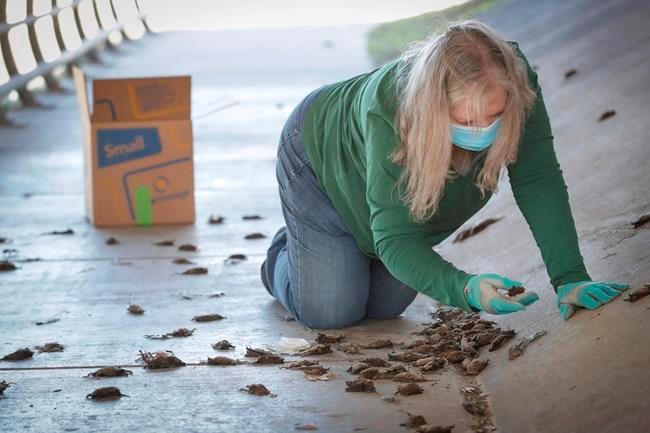DALLAS — As many people in the southern U.S. hosted
Starving and disoriented, the winged mammals tumbled to the snow-coated ground as temperatures plunged to levels rarely seen in the region.
“They burned through their energy reserves as they tried to wake up and get away from the cold and ice," said Rugroden, of Arlington, Texas, one of numerous rehabilitation specialists nursing stranded bats plucked up by sympathetic people. “And there aren't any insects out there for them to eat yet."
Bats are among numerous wildlife believed to have taken a beating in the South, a region unaccustomed to such a severe and prolonged cold snap. Many species migrate there for winter precisely because of its normally mild weather.
It might take weeks or months to determine the extent of the harm, but anecdotal evidence is already turning up — including dead robins on yards and sidewalks.
Alligators in Oklahoma's Red Slough Wildlife Management Area were photographed with snouts protruding from frozen waterways — a survival
Fish kills were feared in Arkansas and Louisiana. The Texas Parks and Wildlife Department said it expected casualties among exotic deer and antelope. Across the Gulf of Mexico coast as far east as Florida, naturalists worried about monarch butterflies and the milkweed plants essential to their survival as they prepare to migrate northward.
“Animals can respond to events like this by moving elsewhere, but if it's beyond your flight range or your walking range you have to hunker down,” said Perry Barboza, a wildlife biologist at Texas A&M University. “Some animals like small birds can do it just a night or two. The duration becomes the killer."
Sea turtles stunned by frigid Gulf coastal waters were still being cared for at facilities this week. More than 10,600 had been found and officials were tabulating how many died, said Donna Shaver, Texas
Sea Turtle Inc. took in so many that it used the South Padre Island Convention Center to accommodate the overflow, executive director Wendy Knight said.
“Our hospital is now completely filled to the gills,” Knight said.
Fish kills along the Texas coast were expected for recreational
The Arkansas Game and Fish Commission warned anglers to expect die-offs of threadfin shad, a primary food source for lake species such as bass, walleye and crappie.
While extreme weather is particularly dangerous for imperiled species, the whooping crane — listed by the federal government as endangered — appears to have weathered the storm, said Joe Saenz, manager of the Aransas National Wildlife Refuge in Texas.
About 500 of the majestic birds spend winters at the refuge before returning to Canadian nesting grounds. During the cold spell, some were spotted feasting on dead fish floating on the Gulf waters.
Biologists are concerned about monarch butterflies, which the U.S. Fish and Wildlife Service in December designated as a candidate for endangered or threatened status because of a sharp decline in recent decades.
The biggest monarch population winters in Mexican mountains and begins its northward trek in March. Had the cold spell happened a few weeks later, the orange-and-black butterflies could have been devastated, said Ray Moranz, an Oklahoma-based scientist.
They still might not escape unscathed. Some typically spend winters along the Gulf coast, where their odds during the deep freeze were poor, said Moranz, of the Xerces Society for Invertebrate Conservation.
Another potential danger is to milkweed, which provides spots for female monarchs to lay eggs and food for their larvae. If the plants' growth across the South is stunted, more young would not survive.
That situation underscores a hazard for wildlife across the region: Even those that made it through the freeze might see damaged habitat and less food.
In South Texas, bur clover, a winter weed crucial for deer in spring, was showing freeze burn.
Long-term, the biggest concerns are for birds and bats, both of which had absorbed heavy blows even before the storm.
Breeding bird populations in the U.S. and Canada have plummeted nearly 30
Migratory birds don't bother fattening up for winter because food in the South is plentiful, he said. During the storm, many probably burned through their
“You worry about food sources covered in snow — seeds and berries — and a decrease in insect life,” said Ben Jones, executive director of the Texas Conservation Alliance, who found five dead birds in his yard last weekend. Robins, bluebirds, hermit thrushes and gray catbirds were among hard-hit types, he said.
Frozen songbirds also were spotted on streets in Tulsa, Oklahoma, where temperatures plunged to minus-13 degrees last week.
Bats have their own challenges, including a fungal disease called white-nose syndrome that has killed millions. To those struggling to save them, every bat is precious. They eat huge numbers of insects that consume farm crops and carry diseases.
“We're seeing a large population hit,” including migratory bats just arriving from Mexico, said Rugroden, the rehabilitation specialist. A well-known colony living in a Houston bridge appears to have taken big losses.
______
Flesher reported from Traverse City, Michigan.
John Flesher And Jamie Stengle, The Associated Press




